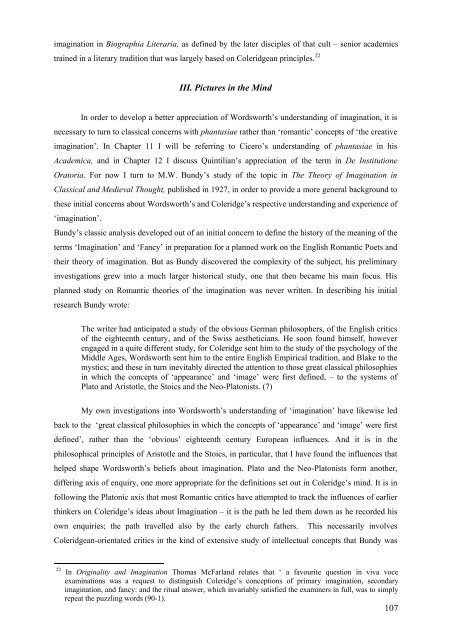Contents - ResearchSpace@Auckland - The University of Auckland
Contents - ResearchSpace@Auckland - The University of Auckland
Contents - ResearchSpace@Auckland - The University of Auckland
You also want an ePaper? Increase the reach of your titles
YUMPU automatically turns print PDFs into web optimized ePapers that Google loves.
imagination in Biographia Literaria, as defined by the later disciples <strong>of</strong> that cult – senior academicstrained in a literary tradition that was largely based on Coleridgean principles. 22III. Pictures in the MindIn order to develop a better appreciation <strong>of</strong> Wordsworth’s understanding <strong>of</strong> imagination, it isnecessary to turn to classical concerns with phantasiae rather than ‘romantic’ concepts <strong>of</strong> ‘the creativeimagination’. In Chapter 11 I will be referring to Cicero’s understanding <strong>of</strong> phantasiae in hisAcademica, and in Chapter 12 I discuss Quintilian’s appreciation <strong>of</strong> the term in De InstitutioneOratoria. For now I turn to M.W. Bundy’s study <strong>of</strong> the topic in <strong>The</strong> <strong>The</strong>ory <strong>of</strong> Imagination inClassical and Medieval Thought, published in 1927, in order to provide a more general background tothese initial concerns about Wordsworth’s and Coleridge’s respective understanding and experience <strong>of</strong>‘imagination’.Bundy’s classic analysis developed out <strong>of</strong> an initial concern to define the history <strong>of</strong> the meaning <strong>of</strong> theterms ‘Imagination’ and ‘Fancy’ in preparation for a planned work on the English Romantic Poets andtheir theory <strong>of</strong> imagination. But as Bundy discovered the complexity <strong>of</strong> the subject, his preliminaryinvestigations grew into a much larger historical study, one that then became his main focus. Hisplanned study on Romantic theories <strong>of</strong> the imagination was never written. In describing his initialresearch Bundy wrote:<strong>The</strong> writer had anticipated a study <strong>of</strong> the obvious German philosophers, <strong>of</strong> the English critics<strong>of</strong> the eighteenth century, and <strong>of</strong> the Swiss aestheticians. He soon found himself, howeverengaged in a quite different study, for Coleridge sent him to the study <strong>of</strong> the psychology <strong>of</strong> theMiddle Ages, Wordsworth sent him to the entire English Empirical tradition, and Blake to themystics; and these in turn inevitably directed the attention to those great classical philosophiesin which the concepts <strong>of</strong> ‘appearance’ and ‘image’ were first defined, – to the systems <strong>of</strong>Plato and Aristotle, the Stoics and the Neo-Platonists. (7)My own investigations into Wordsworth’s understanding <strong>of</strong> ‘imagination’ have likewise ledback to the ‘great classical philosophies in which the concepts <strong>of</strong> ‘appearance’ and ‘image’ were firstdefined’, rather than the ‘obvious’ eighteenth century European influences. And it is in thephilosophical principles <strong>of</strong> Aristotle and the Stoics, in particular, that I have found the influences thathelped shape Wordsworth’s beliefs about imagination. Plato and the Neo-Platonists form another,differing axis <strong>of</strong> enquiry, one more appropriate for the definitions set out in Coleridge’s mind. It is infollowing the Platonic axis that most Romantic critics have attempted to track the influences <strong>of</strong> earlierthinkers on Coleridge’s ideas about Imagination – it is the path he led them down as he recorded hisown enquiries; the path travelled also by the early church fathers. This necessarily involvesColeridgean-orientated critics in the kind <strong>of</strong> extensive study <strong>of</strong> intellectual concepts that Bundy was22 In Originality and Imagination Thomas McFarland relates that ‘ a favourite question in viva voceexaminations was a request to distinguish Coleridge’s conceptions <strong>of</strong> primary imagination, secondaryimagination, and fancy: and the ritual answer, which invariably satisfied the examiners in full, was to simplyrepeat the puzzling words (90-1).107














